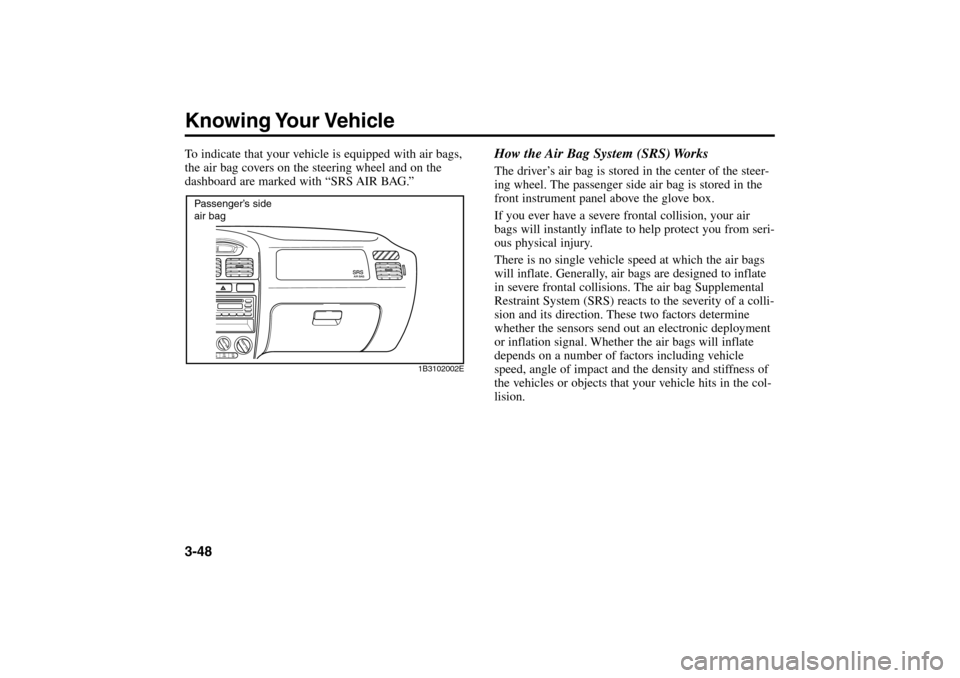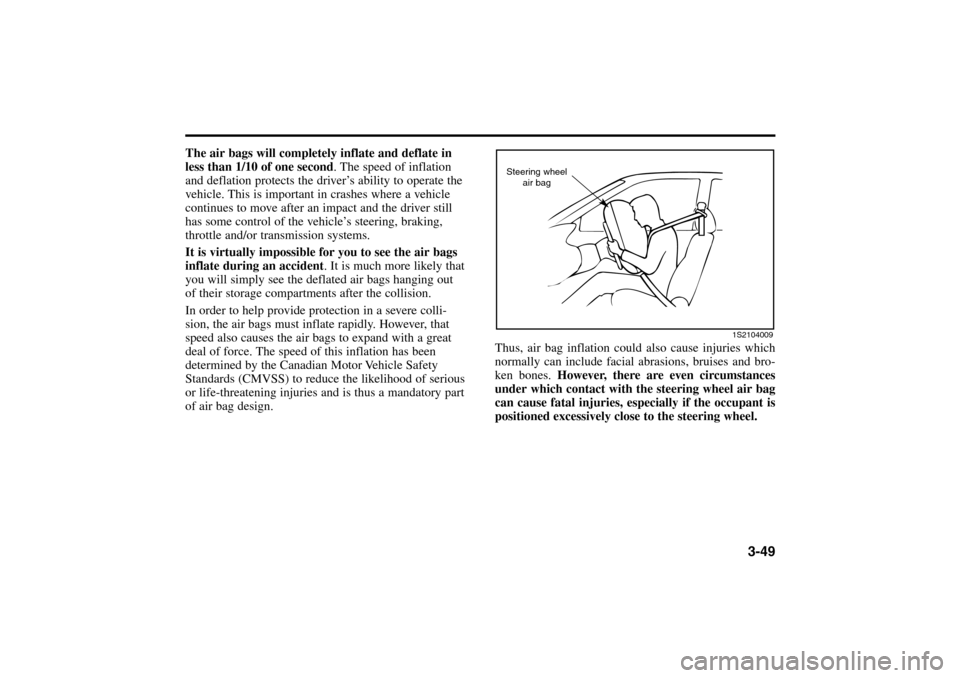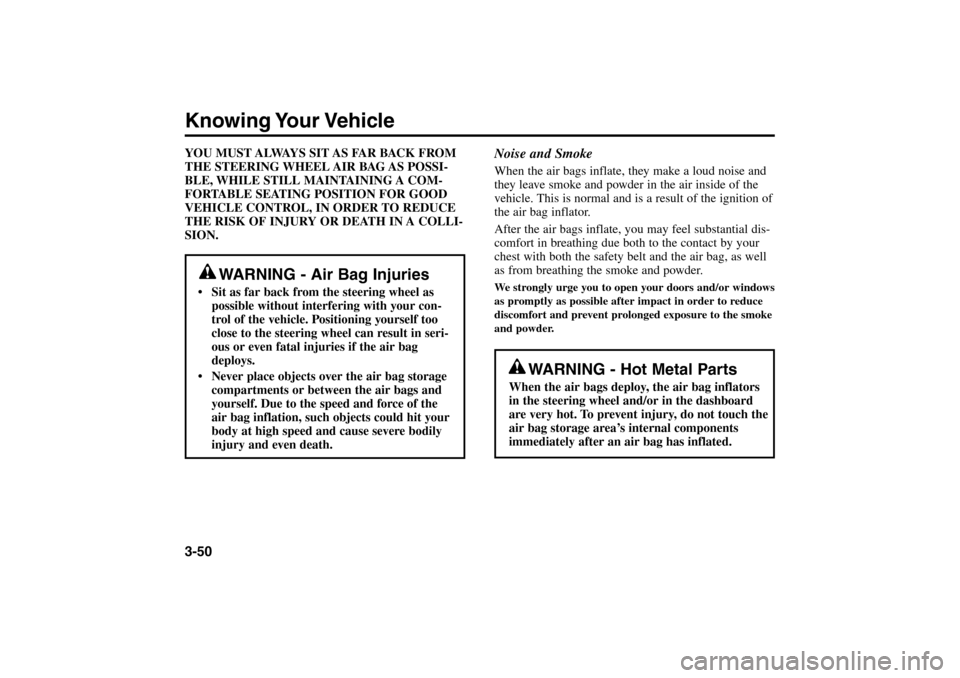KIA Rio 2005 2.G Workshop Manual
Manufacturer: KIA, Model Year: 2005, Model line: Rio, Model: KIA Rio 2005 2.GPages: 238, PDF Size: 2.6 MB
Page 51 of 238

3. Insert the tongue plate into the open end of the
buckle until an audible “click’’ is heard, indicating
the belt is locked.
3-41
4. Position the lap portion of the belt across your lap
as LOW ON THE HIPS as possible to reduce the
risk of sliding under it during an accident. Adjust
the belt to a SNUG FIT by pulling up on the shoul-
der portion of the safety belt. The belt retractor is
designed to take up excess webbing automatically
and to maintain tension on the belt. This is for your
safety. Do not put excess slack into the safety belt.
2BLA3722BLA373
Too high Take up slack
Keep as low on hip bone as possible
RIO ENG CNA 3.qxd 7/29/05 5:13 PM Page 41
Page 52 of 238

To Unfasten:
Press the release button on the buckle.Knowing Your Vehicle3-42
WARNING - Rear Lap/Shoulder
Safety Belts
Never wear the shoulder portion of the safe-
ty belt under the outside arm or behind the
back.
Never wear the shoulder portion of the safe-
ty belt across the neck or face.
Wear the lap belt or the lap portion of the
belt as low as possible. Be sure the lap belt
fits snugly around the hips. Never wear the
lap belt over your waist.
Never ride or drive with a twisted or
jammed safety belt. If you cannot untwist or
unjam the safety belt, see the nearest Kia
dealer immediately.
Never use a single belt to restrain more than
one person at a time.
Failure to follow these warnings could increase
the chance and severity of injury in an acci-
dent.
2BLA374
RIO ENG CNA 3.qxd 7/29/05 5:13 PM Page 42
Page 53 of 238

2. To lengthen the belt, hold the latch plate tongue at a
right angle to the safety belt webbing and pull.
3. To shorten the belt, hold the latch plate tongue at a
right angle to the safety belt webbing and pull on
the loose end of the belt until the desired belt
length is reached.
3-43 Lap Belt Only (Rear Center Seat)
To Fasten the Rear Lap Belt:
1. Grasp the buckle end and pull it low over the
abdomen. Insert the tongue plate into the open end
of the buckle until an audible “click’’ is heard, indi-
cating the latch is locked. Make sure the belt is not
twisted.
2BLA376/2BLA377
PRESSC
E
N
T
E
R
C
E
N
T
E
R
AS2B03029
RIO ENG CNA 3.qxd 7/29/05 5:13 PM Page 43
Page 54 of 238

Knowing Your Vehicle3-44
To Unfasten the Rear Lap Belt:
Press the release button on buckle.
PRESSC
E
N
T
E
R
CENTER
2BLA375A
4. Grasp the free portion of the belt webbing and pull
until the belt is snug over the hips and as low on
the abdomen as possible.
5. Make sure that the belt is placed as LOW ON THE
HIPS as possible.
2BLA378/2BLA379
RIO ENG CNA 3.qxd 7/29/05 5:13 PM Page 44
Page 55 of 238

3-45 Proper Use and Care of the Safety Belt System
To ensure that the safety belts provide the maximum
protection, please follow these instructions:
Use the belts at all times - even on short trips.
If the safety belt is twisted, straighten it prior to use.
Keep sharp edges and damaging objects away from
the belts.
Periodically inspect belt webbing, anchors, buckles,
and all other parts for signs of wear and damage.
Replace damaged, excessively worn or questionable
parts immediately.
WARNING - Center Rear
Lap Belt
Be sure the center rear lap belt is positioned
snugly around the hips, and not on the waist.
Failure to position the center rear lap belt
snugly around the hips and not on the waist
will increase the chance and severity of injury
in the event of a collision.
To clean the belt webbing, use any mild soap solu-
tion recommended for cleaning upholstery or car-
pets. Follow the instructions provided with the soap.
Do not bleach or dye the webbing because this may
weaken the webbing fibers and allow them to fail
when loaded in a collision.
Do not make modifications or additions to the safety
belt.
After wearing a safety belt, make sure it fully
retracts to the stowed position. Do not allow the belt
to get caught in the door when you close it.
RIO ENG CNA 3.qxd 7/29/05 5:13 PM Page 45
Page 56 of 238

Knowing Your Vehicle3-46
In other words, just because your vehicle is damaged
and even if it is totally unusable, don’t be surprised
that the air bag(s) did not inflate.
The Importance of Using Safety Belts
There are four very important reasons to use safety
belts even with an air bag system, they:
Help keep you in the proper position (away from the
air bag) when it inflates.
Reduce the risk of harm in rollover, side or rear
impact collisions, because an air bag is not designed
to inflate in such situations.
Reduce the risk of harm in frontal collisions that are
not severe enough to activate the supplemental
restraint system.
Reduce the risk of being thrown from your vehicle.
WARNING - Air Bags & Safety
Belts
Even in vehicles with air bags, you and your
passengers must always wear the safety belts
provided in order to minimize the risk and
severity of injury in the event of a collision or
rollover. (Continued)
Air Bag – Supplemental Restraint SystemWhat Your Air Bag System Does
Your vehicle is equipped with a dual Supplemental
Restraint System (SRS), which includes an air bag for
the driver (standard) and another air bag for the front
passenger (optional).
What Your Air Bag System Does Not Do
The air bag system is designed to supplement or add to
the protection provided to properly belted occupants in
moderate to severe frontal collisions. It is not a substi-
tute for the driver’s or front passenger’s safety belt and
it does not provide restraint to the lower body.
Why Didn’t My Air Bag Go Off in a Collision?
There are many types of accidents in which the air bag
would not be expected to provide additional protection.
These include side or rear impacts, rollovers, and sec-
ond or third impacts in multiple-impact accidents as
well as low speed impacts.
Remember: air bags are onl
ydesigned to inflate when
the impact would throw the occupant into the air bags
– generally from a little to the left to a little to the
right of straight ahead.
RIO ENG CNA 3.qxd 7/29/05 5:13 PM Page 46
Page 57 of 238

3-47
(Continued)
Always wear your safety belt. It can help
keep you away from the air bags during
heavy braking just before a collision.
Air bags are designed to inflate only in
severe frontal collisions and will generally
not provide protection in side or rear
impacts, rollovers or less severe frontal colli-
sions. They will also not provide protection
from later impacts in a multi-impact colli-
sion.
If your vehicle has been subjected to flood
conditions (e.g. soaked carpeting/standing
water on the floor of the vehicle, etc.) or if
your vehicle has become flood damaged in
any way, do not attempt to start the vehicle
or put the key in the ignition before discon-
necting the battery. This may cause air bag
deployment, which could result in serious
personal injury or death. Have the vehicle
towed to an authorized Kia dealer for
inspection and necessary repairs.
Air Bag System ComponentsThe main components of your vehicle’s SRS are:
One air bag in the steering wheel for the driver, and
another in the dashboard for the front passenger.
A diagnostic system that continually monitors sys-
tem operation.
An indicator light to warn you of a possible problem
with the system.
Emergency power backup in case your car’s electri-
cal system is disconnected in a crash.
1B3102002E
Driver’s side
air bag
RIO ENG CNA 3.qxd 7/29/05 5:13 PM Page 47
Page 58 of 238

To indicate that your vehicle is equipped with air bags,
the air bag covers on the steering wheel and on the
dashboard are marked with “SRS AIR BAG.”Knowing Your Vehicle3-48How the Air Bag System (SRS) Works
The driver’s air bag is stored in the center of the steer-
ing wheel. The passenger side air bag is stored in the
front instrument panel above the glove box.
If you ever have a severe frontal collision, your air
bags will instantly inflate to help protect you from seri-
ous physical injury.
There is no single vehicle speed at which the air bags
will inflate. Generally, air bags are designed to inflate
in severe frontal collisions. The air bag Supplemental
Restraint System (SRS) reacts to the severity of a colli-
sion and its direction. These two factors determine
whether the sensors send out an electronic deployment
or inflation signal. Whether the air bags will inflate
depends on a number of factors including vehicle
speed, angle of impact and the density and stiffness of
the vehicles or objects that your vehicle hits in the col-
lision.
1B3102002E
Passenger’s side
air bag
RIO ENG CNA 3.qxd 7/29/05 5:13 PM Page 48
Page 59 of 238

3-49
The air bags will completely inflate and deflate in
less than 1/10 of one second. The speed of inflation
and deflation protects the driver’s ability to operate the
vehicle. This is important in crashes where a vehicle
continues to move after an impact and the driver still
has some control of the vehicle’s steering, braking,
throttle and/or transmission systems.
It is virtually impossible for you to see the air bags
inflate during an accident. It is much more likely that
you will simply see the deflated air bags hanging out
of their storage compartments after the collision.
In order to help provide protection in a severe colli-
sion, the air bags must inflate rapidly. However, that
speed also causes the air bags to expand with a great
deal of force. The speed of this inflation has been
determined by the Canadian Motor Vehicle Safety
Standards (CMVSS) to reduce the likelihood of serious
or life-threatening injuries and is thus a mandatory part
of air bag design.Thus, air bag inflation could also cause injuries which
normally can include facial abrasions, bruises and bro-
ken bones. However, there are even circumstances
under which contact with the steering wheel air bag
can cause fatal injuries, especially if the occupant is
positioned excessively close to the steering wheel.
1S2104009
Steering wheel
air bag
RIO ENG CNA 3.qxd 7/29/05 5:13 PM Page 49
Page 60 of 238

Knowing Your Vehicle3-50YOU MUST ALWAYS SIT AS FAR BACK FROM
THE STEERING WHEEL AIR BAG AS POSSI-
BLE, WHILE STILL MAINTAINING A COM-
FORTABLE SEATING POSITION FOR GOOD
VEHICLE CONTROL, IN ORDER TO REDUCE
THE RISK OF INJURY OR DEATH IN A COLLI-
SION.
WARNING - Air Bag Injuries
Sit as far back from the steering wheel as
possible without interfering with your con-
trol of the vehicle. Positioning yourself too
close to the steering wheel can result in seri-
ous or even fatal injuries if the air bag
deploys.
Never place objects over the air bag storage
compartments or between the air bags and
yourself. Due to the speed and force of the
air bag inflation, such objects could hit your
body at high speed and cause severe bodily
injury and even death.
Noise and SmokeWhen the air bags inflate, they make a loud noise and
they leave smoke and powder in the air inside of the
vehicle. This is normal and is a result of the ignition of
the air bag inflator.
After the air bags inflate, you may feel substantial dis-
comfort in breathing due both to the contact by your
chest with both the safety belt and the air bag, as well
as from breathing the smoke and powder. We strongly urge you to open your doors and/or windows
as promptly as possible after impact in order to reduce
discomfort and prevent prolonged exposure to the smoke
and powder.
WARNING - Hot Metal Parts
When the air bags deploy, the air bag inflators
in the steering wheel and/or in the dashboard
are very hot. To prevent injury, do not touch the
air bag storage area’s internal components
immediately after an air bag has inflated.
RIO ENG CNA 3.qxd 7/29/05 5:13 PM Page 50